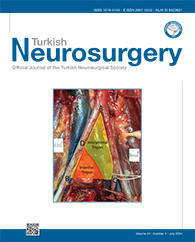Turkish Neurosurgery
2024 , Vol 34 , Num 4
Endovascular Treatment for Ruptured Proximal Anterior Cerebral Artery Dissecting Aneurysm: A Case Series
1Tokyo Medical and Dental University, Department of Endovascular Surgery, Tokyo, Japan2Japanese Red Cross Musashino Hospital, Department of Neurosurgery, Tokyo, Japan
3Tsuchiura Kyodo General Hospital, Department of Neurosurgery, Ibaraki, Japan
4Shioda Memorial Hospital, Department of Neurosurgery, Chiba, Japan DOI : 10.5137/1019-5149.JTN.44098-23.2 Subarachnoid hemorrhage due to the A1 segment of an anterior cerebral artery dissecting aneurysm is rare. Therefore, a standard treatment has not been established. Though several case reports of direct surgery exist, there are few reports on endovascular treatment. This is the first study to describe five patients who underwent endovascular treatment for ruptured A1 dissecting aneurysms. Between January 2001 and December 2022 in our affiliated centers, five cases of SAH-onset A1 dissecting aneurysms were treated with endovascular treatment. We describe in detail two representative cases, briefly summarize the other three, and analyze their complications and outcomes. In the five cases, four were female. Four were in their 50s, and one was in her 80s. The WFNS grades were as follows: three were 2, one was 4, and one was 5. No re-ruptures or symptomatic complications were observed. The modified Rankin Scale scores at the time of discharge were as follows; one was 0, one was 1, two were 2, and one was 5. One in five patients needed retreatment after endovascular trapping because of recanalization. Endovascular treatment may be an effective and viable treatment option for ruptured A1 dissecting aneurysms. Further studies are needed to collect detailed data on complications and outcomes. Keywords : Subarachnoid hemorrhage, Anterior cerebral artery, Dissecting aneurysm, Endovascular therapy





